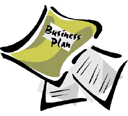It’s time to put all the elements of the business plan together and actually write the plan. This can be an intimidating process for lots of business owners. There’s so much detail that is necessary for the plan, and most people don’t consider themselves professional writers, they worry that they won’t do a good job putting the plan together and may blow any opportunity to get loans or possible investors.
 There’s no reason to feel so much anxiety about the business plan. After all, no one knows your business quite like you do. Probably one of the easiest ways to put the plan together is to focus on it section at a time – don’t look at the plan in its entirety, but plan on writing manageable, bite-size pieces.
There’s no reason to feel so much anxiety about the business plan. After all, no one knows your business quite like you do. Probably one of the easiest ways to put the plan together is to focus on it section at a time – don’t look at the plan in its entirety, but plan on writing manageable, bite-size pieces.
When you start writing, break the plan down the main sections. Within each of these sections, you’ll find it easy to write small amounts, one sub-section at a time. There are some things you can do to make your plan easier to read:
- Make your headings large so the major categories stand out.
- Use sub-headings, but make them an obvious part of the major categories.
- Use bullet points to make it easier to read.
- When ever possible, use charts and graphs, and if possible, use color for extra punch.
Let’s take a look at how the plan should flow:
Your business plan should have a title page. Your title page lists the name of your business, the title “Business Plan”, the address and date and who prepared the plan.
It’s also a good idea to include a statement that the plan is proprietary information. Your business plan reflects your hard work, and under no circumstance should it be available to a business competitor.
Next, your business plan should have a table of contents. Your readers may want to quickly turn to a particular section, so make it easy for them to find that section.
The rest of the plan should follow the standard formula for business plans. Of course, there is some room for you to customize it, but business plans generally are organized along the same format. The rest of the plan should follow more or less the following template:
Executive Summary
The Business
Business Concept
Current Situation
Objectives
The Market
Market Analysis
Market Segmentation
Market Strengths
Market Weaknesses
Target Audience
Competition Overview
Strategies
Marketing Strategies
Sales Strategies
Strategic Alliances
The Management Structure
Description of Key Players
Organization Chart
Estimated Staffing Costs (at end of year 1)
The Financial Plan
Needs Summary
Revenue Model
Assumptions and Comments
The Appendix Section
Supporting Documentation
Financial Statements
Profit and Loss-Year 1
Profit and Loss-Year 2
Profit and Loss-3 Year Summary
Cash Flow-Year 1
Cash Flow-Year 2
Balance Sheet
Implementation Schedule and Milestones
Research and Development
Exit Strategy
Finish off your plan and then spend some time editing. You need to make sure your plan includes any supporting references or documentation. You also need to proof read the document carefully. In fact, you should plan to read through it several times, looking for mistakes. It’s also a good idea to have someone else read through it and looks for errors.
Finally, when you are sure the plan is perfect, make copies and get it bound. You want the plan to be easy to read, easy to flip through, and make sure it stays intact with the pages in order. Good luck with your plan – and more importantly, good luck with your business.
I think one of the most important parts about writing a business plan is to have someone else proofread it. It is the best way to catch easily missed mistakes. However, it also helps if whoever is reading through the plan can also give you pointers on how key parts of the plan, like the finances, can be changed to help make the plan better.